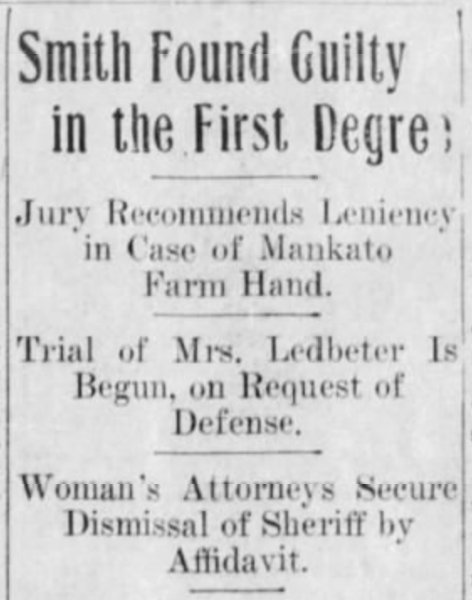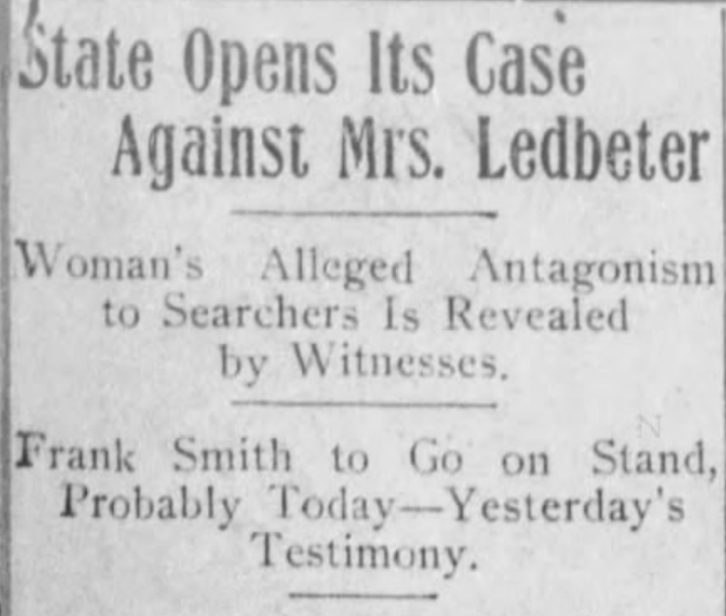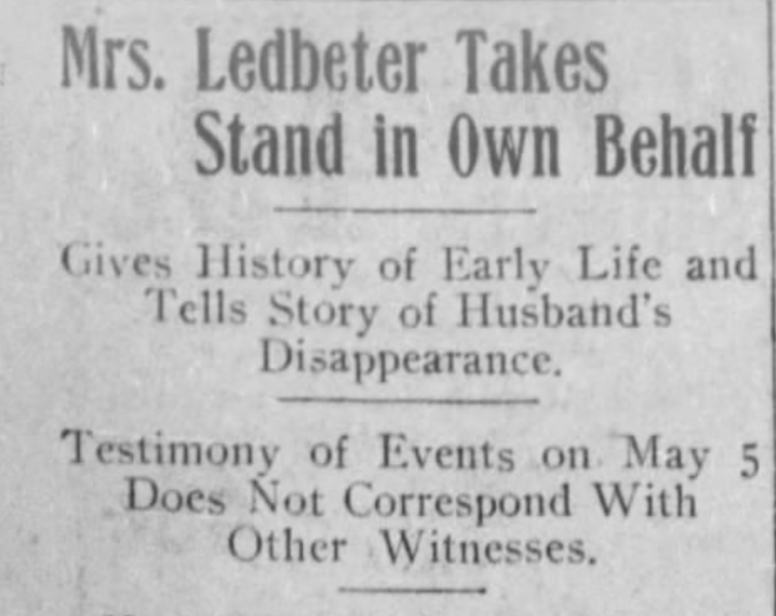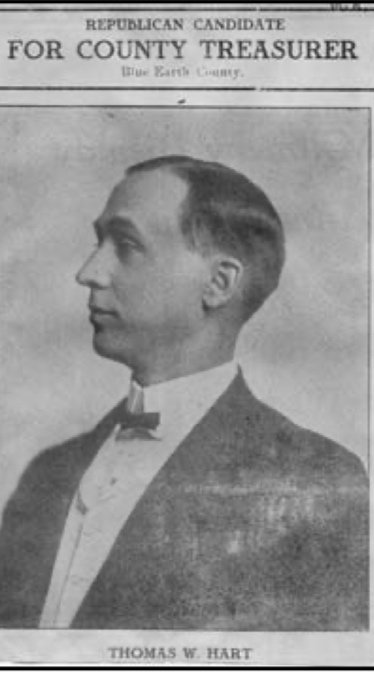Murder in Minnesota: Frank Smith & Grace Ledbeter
On the last day of 1909, the statue of Lady Justice that sits atop the Blue Earth County Courthouse unceremoniously dropped her scales. Legend says that it was in response to the ‘not guilty’ verdict rendered in the trial of Grace Ledbeter.
Why was Lady Justice so disgusted that she threw down her scales? Lets find out.
A HUSBAND DISAPPEARS
On May 5th of 1909, authorities received a report that Holland Ledbeter had disappeared from his farm in Lime Township, near Mankato. The strange thing about the report was that Holland’s wife, Grace, had run to a neighbor for help only 45 minutes after she had last seen her husband.
Grace expressed concern that perhaps her husband was suicidal because of debts that had accumulated on the farm and some business deals that had gone bad.
A posse of local men began searching the farm, but no sign of Holland was found. As the days and then weeks started to pass, rumors and questions started to swirl. Grace, who was about 15 years younger than her missing husband, was living alone on the farm with her daughters and a hired man, Frank Smith. To combat the innuendo, Grace asked her sister, Goldie, and her brother-in-law William Schwandt to come stay with her.
Holland's brother, Philip, also came from Hayward, Wisconsin. He insisted that they keep searching for his brother. The search team used spud bars and muskrat spikes to spear the ground and kept discovering freshly dug holes and freshly turned fields. Searchers noticed that Holland’s dog wouldn’t leave a specific spot in the barn and they soon realized that under the hay was a shallow grave - but no body.
On June 27th, 1909, searchers fanned out in a potato patch that the hired man, Frank Smith, had recently plowed and that’s when they found the body of Holland Ledbeter.
CONFESSION
Frank Smith immediately confessed to the murder, but insisted he didn’t do it alone. He also implicated Grace and the Schwandts. Grace Ledbeter and Smith were charged with first-degree murder and William and Goldie Schwandt were charged as accessories to the crime.
Frank pled ‘not guilty’ to first degree murder, claiming he was only an accessory to the crime and forced into it by Grace. Smith's trial began in the fall of 1909. He claimed that he and Grace Ledbeter had been having an affair for at least a year. She had told him several times that she wanted to kill her husband so that they could be together. He said that on the night of the crime, Grace had gone into the bedroom and bashed Holland’s head with a hatchet. She returned to Frank and simply said, “Well, that’s done”. But when she heard movement from the bedroom, she went back a second time to make sure that Holland was dead. Frank said that there was blood all over the bedroom and that they burned the bloody sheets to hide the evidence. The pair buried the body in the barn, but after two weeks it began to smell. This was when the Schwandts got involved, helping to move the body to the potato patch.
His version of events was pretty convincing and aligned pretty well with what the townsfolk had already assumed. But just as the case was about to go to the jury, two witnesses shocked the courtroom. Detectives from Illinois revealed that Frank Smith's real name was Frank Levandosky - and he was a felon with multiple convictions for forgery. The twist certainly raised questions about Frank’s character, but was it enough to convict him for murder?
In the end, the jury determined he was guilty of first-degree murder. His sentence was a life of hard labor at Stillwater Prison.
GRACE UNDER FIRE
Grace’s trial began almost immediately after Frank was convicted. She and her team of three lawyers - including A. R. Pfau who was the SON OF THE PRESIDING JUDGE - presented a very different version of events.
Grace took the stand and told the jury how she and her family had dinner, as usual, and went to bed on the night of the 4th. The morning of the 5th, she watched as her husband went into the barn. She got distracted tying her boots and then looked to see where he was. When he didn’t come back out of the barn, she immediately became alarmed. Why?
Two weeks earlier, Frank Smith had told her that he had stopped Holland in the middle of attempting to commit suicide. Compounded with their mounting debts, Grace believed him and was terrified that he had finally succeeded in his aim. She ran to the neighbors for help and the search began, all the while Grace still held hope that Holland was still alive. Frank fed those hopes when, two weeks later, he told Grace that he had seen Holland alive out in the field - but couldn’t explain why he wouldn’t return home. She presumes that Frank told her this story to distract her when he moved the body from the barn to the potato patch. Grace’s hopes were dashed when the searchers found Holland’s body.
Local “experts” were called to the stand to testify to the condition in which Holland’s body was found. Frank Smith had claimed that Grace had killed Holland with a hatchet in the bedroom while he slept. But the experts revealed that Holland was found fully dressed, had his mittens in his pockets, and a wad of tobacco in his mouth.
There’s more to know about one of these experts - we’ll come back to him later.
Grace’s daughters also testified in the trial. They corroborated Grace’s story of seeing Holland the morning of the 5th and denied that they ever saw any evidence of bloodshed in the house. There was no blood in their parents’ bedroom. They also testified that their father did not chew tobacco in the house and that there was no spitoon in the bedroom or tobacco stains on the walls (gross).
Frank Smith was called to testify against Grace, but upon taking the stand he plead the 5th in response to all questions, refusing to incriminate himself.
The jury only deliberated a short time before announcing Grace ‘NOT GUILTY’ on New Year’s Eve, 1909 and Lady Justice atop the courthouse dropped her scales.
The Mankato locals, who weren’t fond of Grace, were disappointed by the verdict. They held an “indignation meeting” protesting the decision that was attended by more than 600 citizens who all agreed that Lady Justice dropped her scales because justice was denied in the case.
JUSTICE RESTORED
Grace and her children went to live with family in Wisconsin. The charges against the Schwandts were dropped. Frank Smith/Levandosky lived out his days in the Stillwater Prison. Lady Justice got a new set of scales in 1975.
FROM EXPERT TO AUTHOR
One of the “experts” that was called to testify in Grace’s trial was a local businessman named Tom Hart. He wasn’t a scientist or investigator. He didn’t have data to prove guilt or innocence. He was the owner of the local shoe store in Mankato. He testified that Holland Ledbeter was found with his boots on and that there was mud and hay crusted in the soles of the boots. His testimony went a long way to supporting Grace’s claims that she saw her husband go into the barn - and denied Frank Smith’s claims that he was murdered in his bed.
Tom Hart and his wife, Stella, had three daughters. Their middle daughter, Maud Palmer Hart, was about 17 years old during the trial. Though the family moved away shortly after the trial, Maud’s connection to Mankato would continue throughout her life - and beyond.
Maud Palmer Hart grew up to become Maud Hart Lovelace, the author of the beloved children’s books known as the Betsy-Tacy Series. The books chronicle Maud’s childhood adventures in Mankato (called Deep Valley in the books). The series follows Betsy, Tacy, and Tib from their ‘tween years up until Betsy gets married. The stories are so popular that they have gone through more than thirty printings and are all still available today - but none of the books feature a storyline based on the Ledbeter trial.
The books even made an appearance in the 1998 film, “You’ve Got Mail”, when a bookstore owner (Meg Ryan) shows the books to a young girl who decides to make her nephew (Tom Hanks) buy them all.
The trials of Frank Smith and Grace Ledbeter probably don’t get discussed much outside of the Mankato area. Lady Justice tried again to get our attention in 2013 when she made a quarter turn on her pedestal and dropped her sword. The courts had moved to a newer building in 2009 - maybe she just wanted a new view. She is one of few Lady Justice statues that doesn't wear a blindfold and staring at the same landscape for more than 127 years is more than enough.
Did Frank Smith act alone or was Grace Ledbeter an accomplice? Do you think small town politics played into peoples’ opinions of Grace? Have you read the Betsy-Tacy novels? I’ve added them to my reading list for 2022!

























